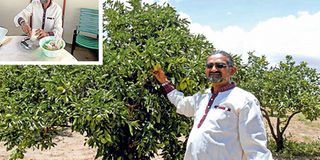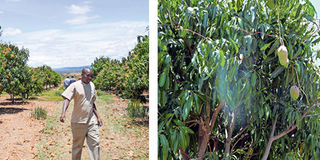Premium
I grew my Garden of Eden in Maasai Mara

Kantilal Dhanji Halai in his fruit orchard near Masai Mara Game Reserve in Narok, and (inset) he peels a fruit in the establishment. He traces his love for nature to his childhood in Nairobi where he would not see a spot where he did not want to plant something. PHOTOS | AUGUSTINE KYALO | NMG
What you need to know:
- An assortment of flowers and herbs adorn the compound, giving it a lush outlook that sharply contrasts with the surrounding environment. Outside the farm, parched land dotted with shrubs goes for as far as the eye can see.
- Suraj also has medicinal trees and herbs as well as several bee hives. Moringa trees, valued for medicinal uses, including the treatment of arthritis, occupy the pride of place in the orchard.
- The yellow-breasted weaver birds, the lilac-breasted roller, the speckled mouse bird, the white-crested Toraco, among others, compete to be heard in the cacophony of their music.
- He wants visitors to get a different experience from that of the nearby park. And even though Suraj charges visitors to his farm, schoolchildren savour the experience for free.
The Narok-Masai Mara road affords you breath-taking sights throughout the 90-kilometre stretch where man and wildlife, modernity and traditional life fuse in perfect harmony.
Herds of elephants grazing within earshot of children herding sheep evoke an idyllic image of wonderland. But it also masks the turmoil that erupts in this land surrounding the world-famous park when increasing drought and livestock population drive wildlife into grazing land, often with deadly consequences.
Some 10 kilometres to Sekenani, the main gate to the Masai Mara Game Reserve, a ‘Maasai Mara Botanical Garden’ sign points to the right.
Follow it for about 40 steps and a gate through a fence of cactus concealing an electric wire leads you to a simple farmhouse.
An assortment of flowers and herbs adorn the compound, giving it a lush outlook that sharply contrasts with the surrounding environment. Outside the farm, parched land dotted with shrubs goes for as far as the eye can see.
Not so for the world of Kantilal Dhanji Halai, popularly known as Suraj, a tree collector whose love for nature has driven him to start a 25-acre orchard where virtually all types of fruit trees grown in Kenya are found.
Besides flowers and herbs, several varieties of avocado, coconut, tamarind, apple, tangerine, lemon, orange, pomegranate, mango and cashew nut are in various stages of ripening.
So are lime, madras thorn, Indian almond, guava, white sapote, jackfruit, plum, peach, pear and tens of other fruit trees not usually associated the hot Mara climate.
PURELY ORGANIC
“If you plant 100 trees, and each gives you 500 fruits and you sell one at Sh10, that is Sh500,000 a year. That is a good income by any standards,” Suraj said. Yet some fruits in his orchard go for as much as Sh1,000 a kilo.
“With enough water and shade, a grapefruit tree can produce 100 to 200 fruits. One can go for as much as Sh200,” he said.
Suraj also has medicinal trees and herbs as well as several bee hives. Moringa trees, valued for medicinal uses, including the treatment of arthritis, occupy the pride of place in the orchard.
“A kilo of moringa roots can sell for Sh20,000 while the leaves go for Sh1,000 at a modest price. One can start making money from the leaves just two years after planting. The leaves alone can give you Sh100,000,” Suraj added.
From the sixth year, powder from the bark is good medicine, according to the patron of National Traditional Health Practitioner’s Association. He plans to plant 100 Moringa trees following demand for its medicine.

Sections of the Maasai Mara Botanical Garden, an establishment owned by Suraj, as he is populatly known in the area. He wants visitors to get a different experience from that of the nearby park. PHOTOS | AUGUSTINE KYALO | NMG
A key feature of Suraj’s orchard is that he has gone purely organic, refusing to allow chemicals into his farm. He lets birds roam the farm freely, pecking at the fruits as they wish.
This has helped him eradicate pests, which would have done greater damage than what the birds would ever do. To walk around the farm is, therefore, to relish a cool shade and to enjoy merry music from the birds of the Mara.
The yellow-breasted weaver birds, the lilac-breasted roller, the speckled mouse bird, the white-crested Toraco, among others, compete to be heard in the cacophony of their music.
And Suraj never stops talking fondly of his fruits. We stop at a pomegranate. “It is good for stopping a running stomach,” he informs me.
NATURE TOURISM
“My advice to farmers is to mix fruits so that you can sell throughout the year,” he says as we enjoy a giant grapefruit.
To enrich his soil, Suraj uses manure from the surrounding manyattas and waste from the farm. He advises farmers to compost waste before using it so as to avoid taking worms to the crops.
To ensure there is round-the-clock water for his orchard, Suraj has two pans. He sells the fruits at local markets to help meet the expenses of running the farm.
His forte, though, is nature tourism. He hopes to make more money from the four rooms he has set up for visitors. He charges Sh3,000 a night.
He wants visitors to get a different experience from that of the nearby park. And even though Suraj charges visitors to his farm, schoolchildren savour the experience for free.
He traces his love for nature to his childhood in Nairobi where he could not see a spot where he did not want to plant something.
He is now planning to introduce game drives and offer courses on herbal medicine and orchard management.
After leaving Eastleigh High School, Suraj joined his family construction business, but maintained his love for nature.
On his retirement nine years ago, he settled in the Mara where he enjoys nature at its wildest. An occasional elephant or zebra would have loved to have a slice of the orchard too were it not for the electric fence surrounding it.




